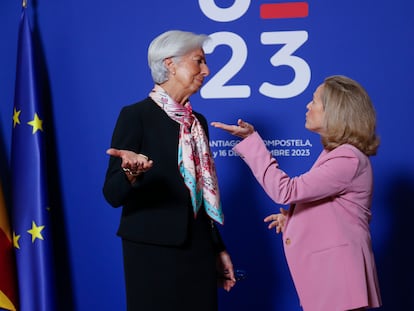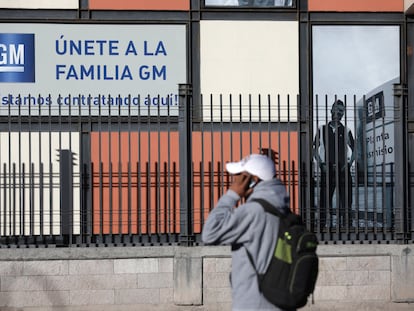Inflationary opportunism
Now is not the time to change the 2% target, but there is room for improvement to correct the pre-pandemic deflationary bias

Good strikers know that you mustn’t be there, you must arrive. The key to scoring is opportunism in losing the mark, attacking space, catching the defense off guard. The inflationary episode of the last two years has had a high component of opportunism. During the pre-Covid decade, companies did not dare to raise prices, fearful of losing market share in the face of increasingly aggressive and global competition. Price stability is a collective exercise, where no one dares to break the balance coordinated by inflation expectations. But the pandemic and the subsequent reopening broke this balance. The macroeconomic volatility generated by the series of shocks that disrupted the global economy — product shortages due to supply bottlenecks, changes in consumption patterns, the increase in energy and raw material prices after the Russian invasion of Ukraine — created the opportunity to increase prices, putting aside the fear of losing market share. After all, all companies were raising prices, and consumers, with a buoyant labor market and savings accumulated during the pandemic, had enough purchasing power to absorb them. In economic jargon, companies went from raising prices regularly once a year (time dependent), to raising prices more frequently depending on the macroeconomic situation (state dependent).
Faced with this opportunistic inflation, central banks adopted a three-stage strategy. First, raise interest rates from zero to levels more in line with the macroeconomic environment. With the labor market at full employment, interest rates had to be raised quickly to at least their neutral level, the interest rate that stabilizes the economy at its potential. But since inflation was above the target, even if it was mostly due to transitory shocks, the second stage required a further rise in rates above the neutral rate to slow the economy below its potential and thus anchor inflation expectations and ensure a return of inflation to the target once the transitory shocks disappear. It was prudent risk management: the inflationary risk was greater than the deflationary risk, and that flank had to be protected.
This second stage is difficult to calibrate, since the neutral interest rate is not observable and you have to tread very carefully. If the adjustment is exaggerated, the economy can enter an unnecessary recession; if it is not adjusted enough, inflation can get out of control. In fact, central banks have been surprised to find that the neutral rate is higher than they thought — the economy is more resistant to interest rate increases than expected — which explains why interest rates have risen more than initially expected.
And from there begins the current third stage, even more complicated. Because it requires maintaining interest rates above their neutral level – that is, with a restrictive effect on the economy – for as long as necessary, so that the economy gradually decelerates and inflation, little by little, returns to the target. A different strategy could be adopted: raise rates much higher, create a recession that ensures inflation slows quickly, and then lower rates to restore economic growth. It would be a more activist strategy, which would introduce more macroeconomic volatility, and therefore less desirable.
This third stage is an opportunistic disinflation strategy: taking advantage of the drop in commodity prices, and the resolution of supply chain bottlenecks, to generate a disinflation that has minimum cost for economic activity. With the economic outlook less rosy and lower macroeconomic volatility, companies will likely resume protecting market share and raising prices less frequently. It is a difficult strategy to communicate: until now, rate hikes were easily explained as inflation was high and rising. From now on, central banks will have to explain why, although inflation is slowing and growth is weakening, interest rates still cannot be lowered. It is like antibiotics: you must take them until the end, even if it seems like the disease has already subsided. Only when there is certainty that inflation will converge to the target within a reasonable horizon can rate cuts be considered.
The completion of the third stage will require deciding the level at which to stabilize inflation, which will surely be the subject of debate. The 2% goal was defined in the 1990s for a world very different from today. It was a world of much less volatility in terms of macroeconomic policy and of higher neutral interest rate, where the probability of the economy falling into a prolonged period of zero interest rates was estimated to be minimal. Reality has shown that this was not the case, with the long decade of zero interest rates. It is true that the neutral interest rate has increased a little in recent years. And that the risks of inflation have becomes more balanced: upwards due to the new economic policy focused on geostrategy, national security and the energy transition, downwards due to the improvement in productivity derived from the expansion of artificial intelligence and the effect of the “Amazon effect” in the service sector. But it seems clear that if the 2% target was adequate in the 1990s, it is probably too low now.
Now is not the time to change the 2% objective, the price shock is very recent and would generate popular rejection. But there is room for improvement to correct the deflationary policy bias existing prior to the pandemic and avoid repeating the mistake of tolerating excessively low inflation. And to do this, central banks must adopt a strategy of stabilizing inflation close to, but above, 2%, during periods of economic expansion, including the current one. Knowing that inflation declines during recessions, this would guarantee 2% inflation in the medium term.
This is the opportunistic reflation strategy that we recommended in The Paradox of Risk back in 2017: taking advantage of a positive price shock to consolidate 2 percent as a symmetrical objective, and not an upper limit. Crises create opportunities, which central banks should take advantage of, as good strikers do.
Tu suscripción se está usando en otro dispositivo
¿Quieres añadir otro usuario a tu suscripción?
Si continúas leyendo en este dispositivo, no se podrá leer en el otro.
FlechaTu suscripción se está usando en otro dispositivo y solo puedes acceder a EL PAÍS desde un dispositivo a la vez.
Si quieres compartir tu cuenta, cambia tu suscripción a la modalidad Premium, así podrás añadir otro usuario. Cada uno accederá con su propia cuenta de email, lo que os permitirá personalizar vuestra experiencia en EL PAÍS.
¿Tienes una suscripción de empresa? Accede aquí para contratar más cuentas.
En el caso de no saber quién está usando tu cuenta, te recomendamos cambiar tu contraseña aquí.
Si decides continuar compartiendo tu cuenta, este mensaje se mostrará en tu dispositivo y en el de la otra persona que está usando tu cuenta de forma indefinida, afectando a tu experiencia de lectura. Puedes consultar aquí los términos y condiciones de la suscripción digital.
More information
Últimas noticias
Maduro to be tried in the US for narcoterrorism and corruption
Maps of the US attack on Venezuela: Targets, airspace and deployed fleet
Venezuelans in exile: ‘This could be the end of a very dark chapter for Venezuela, but also the beginning of a time of uncertainty’
Key points of the military attack on Venezuela: Early morning bombings and a ‘captured’ president
Most viewed
- Alain Aspect, Nobel laureate in physics: ‘Einstein was so smart that he would have had to recognize quantum entanglement’
- David King, chemist: ‘There are scientists studying how to cool the planet; nobody should stop these experiments from happening’
- Mexico completes its trade shift with the entry into force of tariffs on China and countries without trade agreements
- Reinhard Genzel, Nobel laureate in physics: ‘One-minute videos will never give you the truth’
- Oona Chaplin: ‘I told James Cameron that I was living in a treehouse and starting a permaculture project with a friend’











































